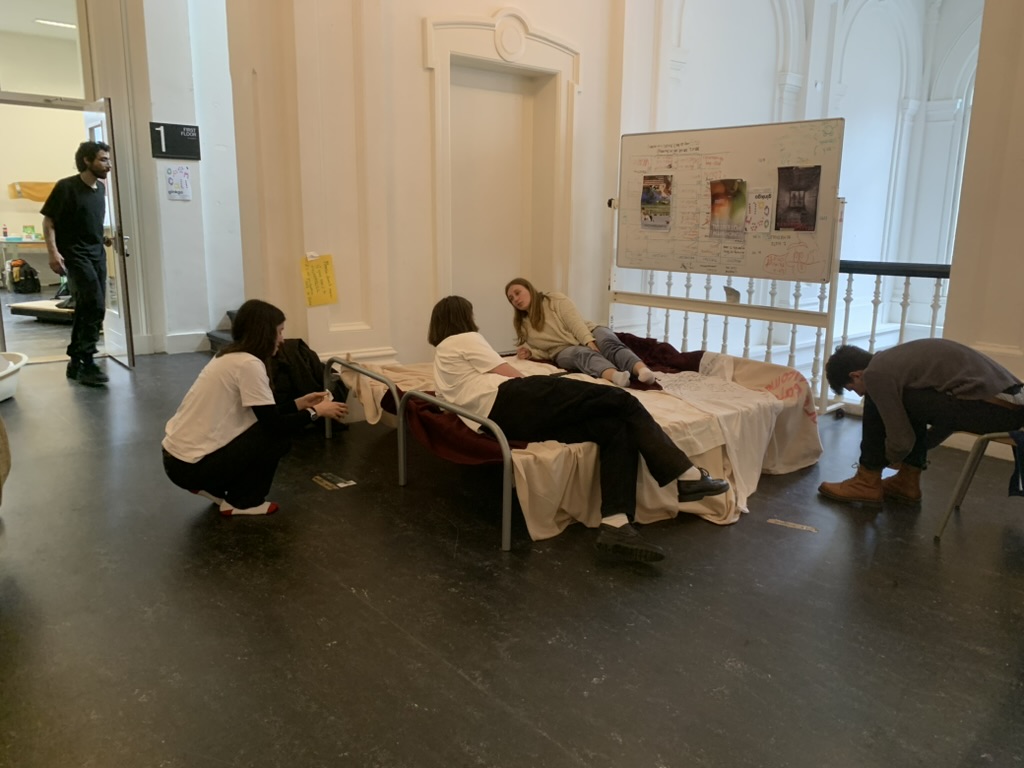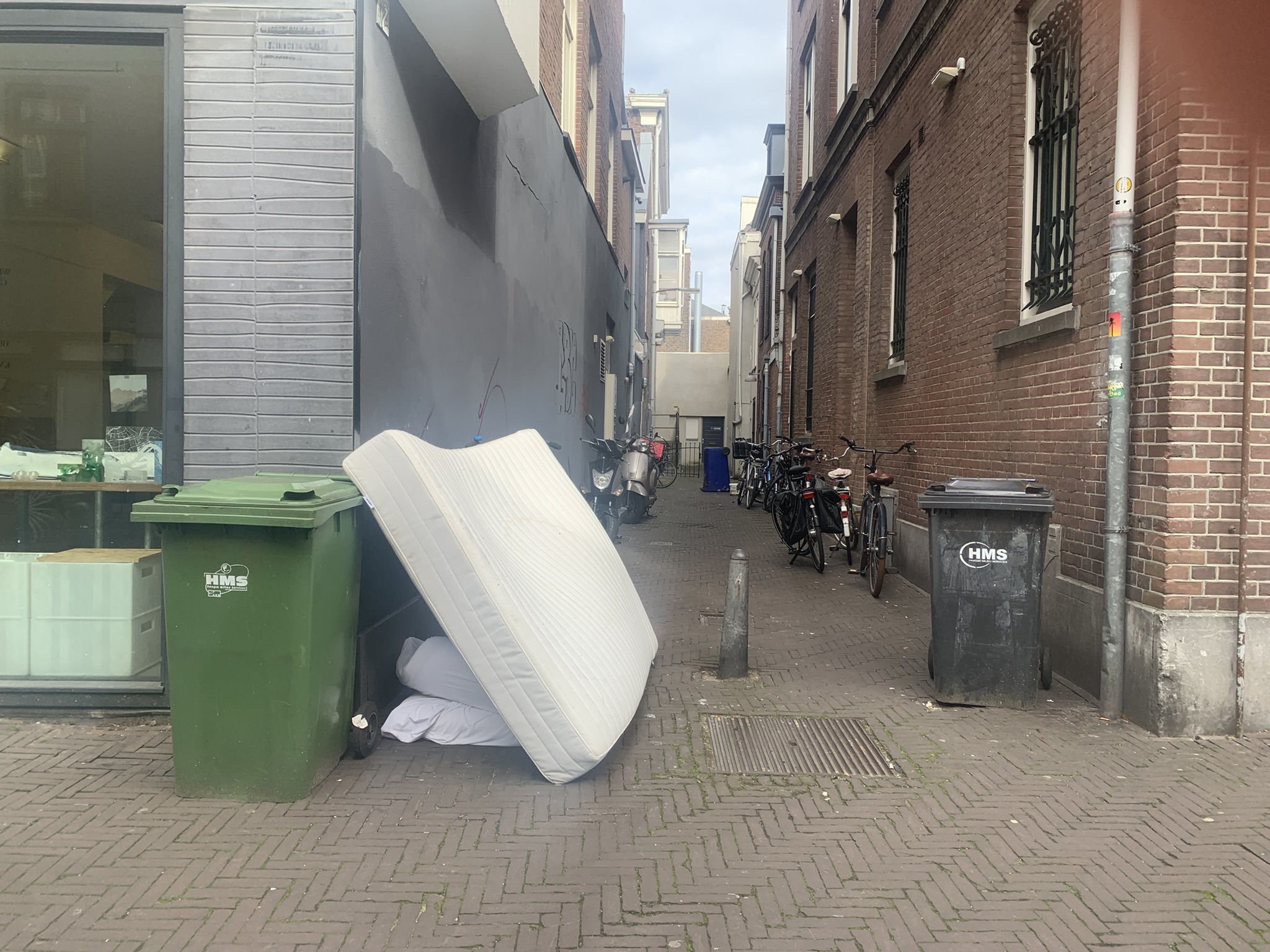The Things We Sleep On:
Across the Borders of Objects
–
Su Kartal
Across the Borders of Objects
–
Su Kartal
The Things We Sleep On is a space that welcomes the audience to engage in conversations while resting. The installation features a sleeping space made up of beds on which I had conversations with people in unconventional public spaces. These conversational moments were documented and can be seen and heard while lying down. This work is a spatial collage that challenges traditional assumptions around sleep.
![]()
The perception that design should address societal issues, combined with my personal history of relocation from early childhood, led me to position my research within the context of displacement. I engaged in conversations in a refugee centre located in The Hague with the desire to gain insight into the ‘normal’ sleeping habits of the residents, and to learn how those habits were forced to change due to displacement. These dialogues shaped the foundation of The Things We Sleep On.
![]()
This spatial collage reveals the outcomes of the research conversations while offering space for new dialogue to take place, creating a space that both shares and provokes thoughts about beds and their associated ideas. The conversations I had with refugees uncovered norms and realities that are generally neglected in design practice. I myself have ingrained beliefs about beds, such as that one needs to have their own bed, located in a private space, possibly elevated, and so on. The Things We Sleep On does not aim to design with or for refugees but instead disrupts presumptions about objects and behaviours, encouraging discussions on sleep and its societal connotations.
![]()
![]()
This project made me rethink the role of design; while the definition of design remains open to discussion, the perception persists that designers are the ultimate problem solvers. I believe design functions within a landscape of complex societal issues such as border politics. I see design neither as the only solution nor as an ineffective practice. Igor Nikolic, engineer and Associate Professor at TU Delft, indentifies complex adaptive systems by their inability to be described through a single language or perspective. I see design as a comprehensive language for making sense of these complexities. The bed's design and the habits that revolve around it reveal a lot about the predominant narration on sleep, about how we sleep and where we sleep. By focusing on the bed, I aim to reveal many stories across the borders of what is usually included in design practice.
![]()
Over the past two years at the Master of Industrial Design department, I have learned the importance of both zooming in to grasp complex details, and zooming out to understand broader contexts. While I am still finding my position within the field, this perspective has taught me to move between analysis and practice. As a designer, I think of myself as a facilitator, using design tools to analyse and inform my practice. I am curious about the dominant narrations of design and eager to uncover the stories and norms behind products.
![]()

The perception that design should address societal issues, combined with my personal history of relocation from early childhood, led me to position my research within the context of displacement. I engaged in conversations in a refugee centre located in The Hague with the desire to gain insight into the ‘normal’ sleeping habits of the residents, and to learn how those habits were forced to change due to displacement. These dialogues shaped the foundation of The Things We Sleep On.

This spatial collage reveals the outcomes of the research conversations while offering space for new dialogue to take place, creating a space that both shares and provokes thoughts about beds and their associated ideas. The conversations I had with refugees uncovered norms and realities that are generally neglected in design practice. I myself have ingrained beliefs about beds, such as that one needs to have their own bed, located in a private space, possibly elevated, and so on. The Things We Sleep On does not aim to design with or for refugees but instead disrupts presumptions about objects and behaviours, encouraging discussions on sleep and its societal connotations.


This project made me rethink the role of design; while the definition of design remains open to discussion, the perception persists that designers are the ultimate problem solvers. I believe design functions within a landscape of complex societal issues such as border politics. I see design neither as the only solution nor as an ineffective practice. Igor Nikolic, engineer and Associate Professor at TU Delft, indentifies complex adaptive systems by their inability to be described through a single language or perspective. I see design as a comprehensive language for making sense of these complexities. The bed's design and the habits that revolve around it reveal a lot about the predominant narration on sleep, about how we sleep and where we sleep. By focusing on the bed, I aim to reveal many stories across the borders of what is usually included in design practice.

Over the past two years at the Master of Industrial Design department, I have learned the importance of both zooming in to grasp complex details, and zooming out to understand broader contexts. While I am still finding my position within the field, this perspective has taught me to move between analysis and practice. As a designer, I think of myself as a facilitator, using design tools to analyse and inform my practice. I am curious about the dominant narrations of design and eager to uncover the stories and norms behind products.
